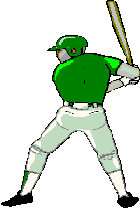![]()


![]()


The following 'rules of the game' are presented to give you a basic understanding about how the 'AAA' Division operates. If you are a spectator in the stands and are not aware that our kids don't play by the Major League rules we are used to when watching games on television, you may not understand why an umpire has ruled a certain way. The following information is being presented to assist you with the 'AAA' Division rules format.
General Rules
1. Two (2 ½ ) hour- time limit No inning shall start after two (2 ½ ) hours of time have elapsed since the official starting time of the game. It shall be held that an inning starts immediately when the third out is made, or the fifth run is scored, ending the preceding inning. This rule applies only when a game is scheduled following on the same field on the same day. It does not apply to the last or only scheduled game of that day. (Note: Time limit is elapsed time from when the game officially began regardless of what time the game was scheduled to begin. Scheduled start time is the time recorded in the official game scorebook as noted by the official scorekeeper by the umpire and the time is kept by the umpire only.)
2. Seven (7) Run Rule - The seventh run scored before three outs are recorded in any half-inning, except the sixth inning, ends that half-inning. No seven run rule will be in effect in the sixth inning or any subsequent inning.
(Note: Applies to all innings before the sixth inning regardless of whether game is called due to time limit, darkness, etc.)
3. Batters shall not fake a bunt, pull back and hit away in the 'AAA' Division. Penalty: Batter shall be called out, whether or not contact was made with the pitch. (Batter must swing to be called out)
4. In case of injury to any runner, the last player listed in the batting order at that time shall be the substitute runner
5. A line-up shall be presented to the home plate umpire prior to the start of the game. Batters must bat in order
6. Base runners leaving early: - a base runner who leaves a base early, that is prior the ball crossing home plate shall be returned to the base from which they left. If the pitched ball is not struck by the batter, the umpire will declare the play dead and send the runner back to the originating base. The result of the pitch will stand as called. If as a result of the pitch the batter strikes the ball and the ball is in play, the play will be allowed to continue. If the runner is put out as a result of the play the out will stand. If the batter is put out as a result of the play the out will stand and the runner who left early will return to the base of origin. If the pitched ball is put in play and no outs are made the runner who left early will only advance to the base to which they would have been forced as a result of the play.
If the runner who left early reaches home safely that runner will be returned to third base, unless occupied by the batter or other runners that were behind the runner that left early.
A runner who leaves early
will only be allowed to score if following runners or the batter score
as a result of the play.
Pitchers
1. Nine(9) year old Pitchers shall only pitch a maximum of three (3) innings per game and six (6) innings per calendar week, Sunday through Saturday.
2. Pitchers will be removed from pitching after hitting two (2) batters in an inning or three (3) batters in a game. That player however, can remain in the game at a different position.
3. Pitchers who intentionally pitch at any batter shall be removed from the game immediately and also be suspended from the next game along with the manager.
4. Players who are league-playing
age 12 are not allowed to pitch in the AAA Division
(These rules are supplemental to the, Minor and Little League rules published annually by Little League Baseball, Inc.)